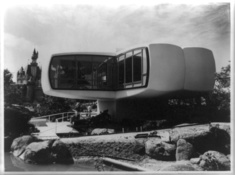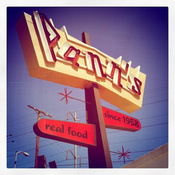
urbansheep@gmail.com
Googie: Architecture of the Space Age | Paleofuture - http://blogs.smithsonianmag.com/paleofu...

|

|
24 июня 2012 в 09:49 с Bookmarklet
bag of dicks to Glasgow
smallq
Our Happy Hardcore
Peter Fedin
"Googie is a modern (ultramodern, even) architectural style that helps us understand post-WWII American futurism — an era thought of as a “golden age” of futurist design for many here in the year 2012. It’s a style built on exaggeration; on dramatic angles; on plastic and steel and neon and wide-eyed technological optimism. It draws inspiration from Space Age ideals and rocketship dreams. We find Googie at the 1964 New York World’s Fair, the Space Needle in Seattle, the mid-century design of Disneyland’s Tomorrowland, in Arthur Radebaugh‘s postwar illustrations, and in countless coffee shops and motels across the U.S. Googie is an odd word; a funny word; a word that feels like it’s doing a few vowel-drenched laps around your tongue before finally flopping out of your mouth. Oddly enough, Googie was used as a deragatory term almost from the start — born in Southern California and named for a West Hollywood coffee shop designed in 1949 by John Lautner, a student of Frank Lloyd Wright. Architecture critic Douglas Haskell was the first to use “Googie” to describe the architectural movement, after driving by the West Hollywood coffee shop and finally feeling like he had found a name for this style that was flourishing in the postwar era." - × × ×
(via MF: http://www.metafilter.com/117230...) - × × ×
© 2015 FriendFeed (and Clio archiver)